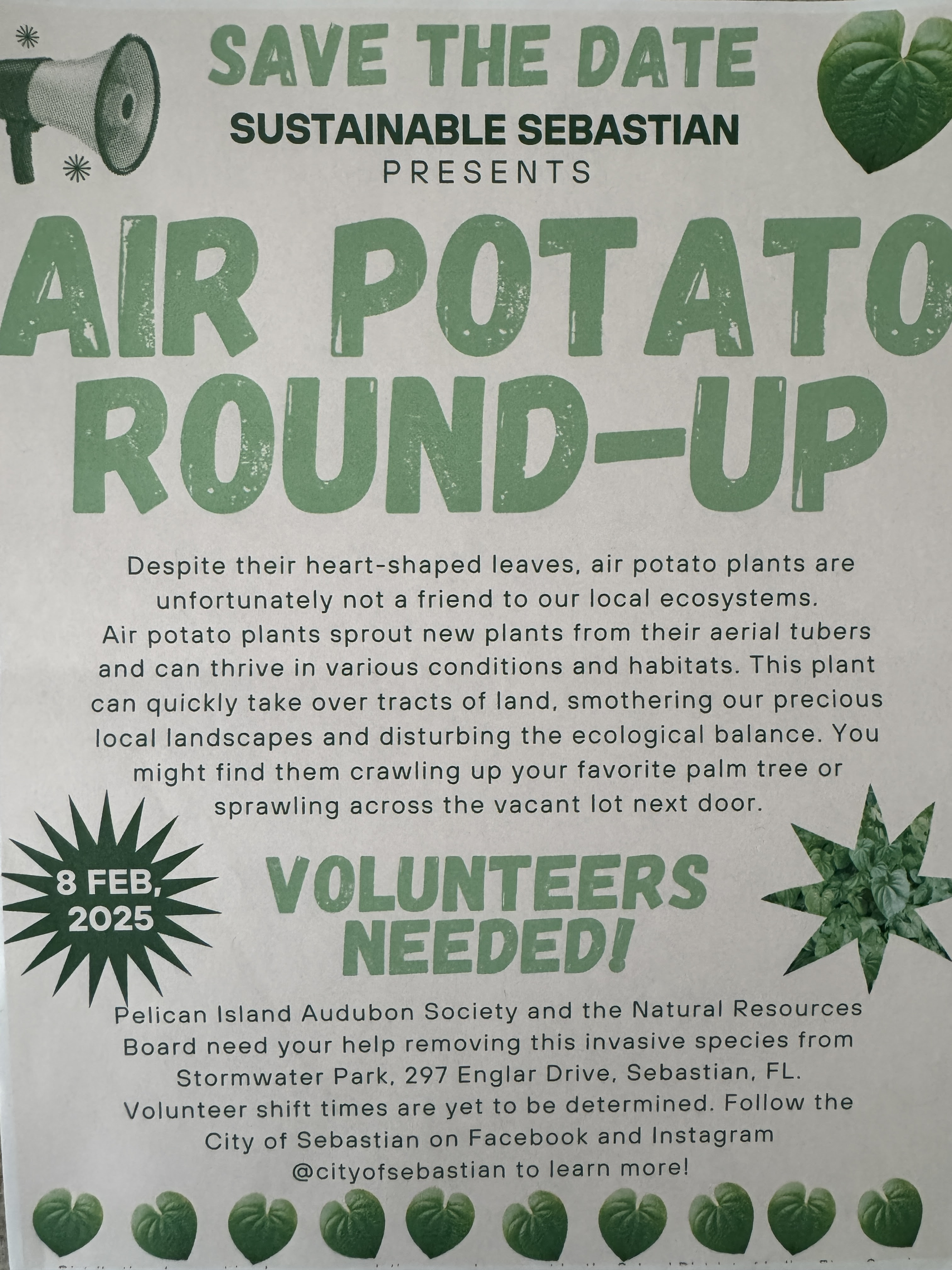Mark your calendars for February 8th, 2025, for the Grand Air Potato Round-Up! Sustainable Sebastian, The Pelican Audubon Society, and the City of Sebastian Natural Resources Board invite you to help control a massive threat to our beautiful Sebastian Stormwater Park, located at 297 Englar Drive, Sebastian, FL 32958.
Florida is known for its lush landscapes and unique ecosystems, but it’s also home to several invasive plant species that threaten its natural beauty. One such plant is the air potato (Dioscorea bulbifera), a fast-growing vine notorious for its ability to take over entire areas, outcompeting native plants and altering ecosystems.
What Is the Air Potato?
The air potato is a species of yam native to Asia and Africa. It was introduced to Florida in the early 1900s as an ornamental plant due to its heart-shaped leaves and rapid growth. Unfortunately, this “decorative” addition to Florida’s flora has proven to be a highly invasive species.
The plant earns its name from the small, potato-like bulbils (aerial tubers) it produces along its vine. These bulbils are not only unsightly when covering native vegetation but also enable the plant’s spread. The bulbils can fall to the ground and grow into new vines, making the air potato extremely difficult to control.
Why Is the Air Potato a Problem?
The air potato vine grows aggressively, with vines reaching up to 70 feet in length in a single growing season. It smothers native plants by blocking sunlight and monopolizing nutrients, leading to a decline in biodiversity. This creates significant challenges in managing natural habitats, particularly in Florida’s wetlands, forests, and conservation areas.
Moreover, the plant’s rapid growth makes it hard to eradicate. Its bulbils can remain dormant for months, meaning that even if you remove the visible vines, new growth can emerge later.
Toxicity Concerns
While some yams are edible, the air potato is not safe for consumption in its raw form. It contains toxic compounds called dioscorine and saponins, which can cause severe health issues if ingested. Some native cultures have used preparation methods to detoxify the tubers, but this is not practical or advisable for casual consumption.
Efforts to Control the Air Potato in Florida
Recognizing the threat posed by the air potato, the Florida Department of Agriculture and other organizations have implemented various measures to control its spread. One of the most effective methods has been the introduction of the air potato leaf beetle (Lilioceris cheni), a biological control agent native to Asia. This small red beetle feeds on the leaves of the air potato vine, significantly reducing its growth and spread without harming native plants.
Manual removal of vines and bulbils is another strategy employed by environmentalists and property owners. However, this is labor-intensive and often requires repeated efforts to fully remove the plant from an area.
How to Identify and Remove Air Potato
The air potato vine is relatively easy to identify. Look for:
Heart-shaped leaves: Large and glossy, resembling those of other yam species. Aerial bulbils: Small, potato-like growths along the vine. Fast growth: The vine can cover large areas in a short time.
To remove it, follow these steps:
Cut and dispose of the vines: Use gloves to protect your hands, as some individuals may experience skin irritation. Collect bulbils: Ensure you remove all bulbils from the ground and vine to prevent regrowth. Monitor for regrowth: Regularly check the area for new shoots and remove them promptly. Consider biological control: Encourage or introduce air potato leaf beetles if they are available in your area.
Protecting Florida’s Ecosystems
The air potato is a cautionary tale about the unintended consequences of introducing non-native plants. While it may have started as a decorative addition, it has become a persistent problem for Florida’s ecosystems. By understanding the risks posed by the air potato and taking steps to control its spread, Floridians can help preserve the natural beauty of their state for future generations.
If you encounter air potato on your property, act quickly to remove it, and consider reaching out to local environmental agencies for guidance. Together, communities can combat this invasive plant and protect Florida’s unique ecosystems.
A Community Stands Stronger Together
If you have an event you would like to share, reach out and send it to us!
 Damien Lee Fey Gilliams
Damien Lee Fey Gilliams 
 Frog Leg Festival 2025: A Leap into Flavor and Fun
Frog Leg Festival 2025: A Leap into Flavor and Fun